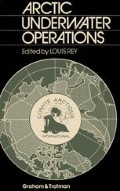Abstract
The physiological problems of hyperbaric exposure are reviewed briefly. Specific physiological responses in humans to diving are considered, together with risks associated with significant habituation and acclimitization. In particular, the rigours of polar diving are stressed.
Access this chapter
Tax calculation will be finalised at checkout
Purchases are for personal use only
Preview
Unable to display preview. Download preview PDF.
References
Bachrach, A. 1982. Performance and physiology in the atmospheric diving system (ADS) JIM-4, Proceedings of the First Annual Canadian Ocean Technology Congress, Defence and Civil Institute of Environmental Medicine, Downsview, Ontario, Canada, pp. 452–465.
Berghage, T. 1978. Man at high pressure: A review of the past, a look at the present and a projection into the future, Marine Technology Society Journal, 12, 18–21.
Boutelier, C., Livingstone, S., Bougues, L. and Read, L. 1982. Physiological, psychophysiological and ergonomic aspects of the exposure of man to Arctic cold (Kool Stool II), M. Radomski, C. Boutelier and A. Buguet (eds) Defence and Civil Institute of Environmental Medicine, Downsview, Ontario, Canada.
Burton, A. and Edholm, O. 1955. Man in a Cold Environment, Edward Arnold, London.
Childs, C. and Norman, J. 1978. Unexplained loss of consciousness in divers, Med. Aero. Spat. Med. Subaquat. Hyper., 17, 127–128.
Davis, F. 1979. Diving and hypothermia, Brit. Med. J., 2, 494.
Diving Medical Advisory Committee (DMAC) 1981. Thermal Stress in Relation to Diving, DMAC Workshop Proceedings, Session Three, Chaired by D. Elliott and F. Golden, pp. 23–30.
Dotto, L. 1977. A vehicle that travels upside-down under the ice, Globe and Mail, 11,
Dunford, R. and Hayward, J. 1981. Venous gas bubble production following cold stress during a no-compression dive, Undersea Biomedical Research, 8, 41–44.
English, J. 1975. Shallow-air saturation dive in the high Arctic, Proceedings of the IEEE Ocean ’75 Conference, pp. 264–267.
Golden, F., Hampton, I. and Smith, D. 1980. Lean long distance swimmers, J. Roy. Nav. Med. Serv., 66, 26–30.
Hayward, M. and Keatinge, W. 1979. Progressive symptomless hypothermia in water — Possible cause of diving accidents, Brit. Med. J., 1, 1182.
James, P. 1981. Human limitations and physiological monitoring in commercial diving, Session B4, Proceedings of Divetech ’81, Society for Underwater Technology, London.
Jenkins, W. 1974. A Guide to Polar Diving, US Office of Naval Research, Arlington, Virginaia.
Kidd, D. and Stubbs, R. 1969. The use of the pneumatic analogue computer for divers, in The Physiology and Niedicine of Diving and Compressed Air Work, P. B. Bennett and D. H. Elliot (eds), Balliére Tindall and Cassell, London, pp. 386–413.
Kidd, D. and Elliott, D. 1969. Clinical manifestations and treatment of decompression sickness in divers, in The Physiology and Medicine of Diving and Compressed Air Work, P. B. Bennett and D. H. Eliott (eds), Baliére Tindall and Cassell, London, pp. 464–490.
Kuehn, L. A., Smith, T. and Bell, D. 1977. Thermal requirements of dives and submersibles in arctic waters, in Arctic Systems, P. Amaria, A. Bruneau and P. Lapp (eds), Plenum Press, New York, pp. 801–831.
MacInnis, J. 1976. The Underwater Arctic: earth’s most hostile frontier. Proceedings of the 1976 Working Diver Symposium, Marine Technology Society, Washington, pp. 196–214.
Middleton, J. 1980. Evaluation of the Kinergetics breathing gas heater for use in open circuit demand breathing apparatus, Thermal Constraints in Diving: 24th Undersea Medical Society Workshop, L. A. Kuehn (ed.), Undersea Medical Society, Bethesda, Maryland, pp. 167–184.
Nuckols, M. 1980. The development of thermal protection equipment for divers, Thermal Constraints in Diving: 24th Undersea Medical Society Workshop, L. A. Kuehn (ed.), Undersea Medical Society, Bethesda, Maryland, pp. 133–166.
Park, Y., Lee, I., Paik, K., Kang, D., Suh, D., Lee, S., Hong, S., Rennie, D. and Hong, S. 1981. Korean women divers revisited: Current status of cold adaption, Undersea Biomedical Research, 8(1-Suppl.), A29.
Park, Y., Rennie, D. and Hong, S. 1983. Status of cold acclimatization in contemporary Korean women wearing wet suits, Underwater Physiology VIII, A. Bachrach (ed.), Undersea Medical Society, Bethesda, Maryland.
Pearson, R. 1981. Why do we need diver monitoring? Session B4, Proceedings of Divetech ’81, Society for Underwater Technology, London.
Piantadosi, C. 1980. Respiratory heat loss limits in helium—oxygen saturation diving, in Thermal Constraints in Diving: 24th Undersea Medical Society Workshop, L. A. Kuehn (ed.), Undersea Medical Society, Bethseda, Maryland, pp. 45–54.
Rawlins, J. and Tauber, J. 1972. Proceedings of the 1972 Working Diver Symposium, Marine Technology Society, Washington, pp. 187–196.
Siple, P. 1945. General principles governing selection of clothing for cold climates, Proc. Amer. Phil. Soc., 89, 177–199.
Tonjum, S., Pasche, A., Onarheim, J., Hayes, P. and Padbury, H. 1983. Cold exposure in heliox environment at 16 bars for 24 hours. Underwater Physiology VIII, A. Bachrach (ed.), Undersea Medical Society, Bethesda, Maryland.
Webb, P. 1974. Thermal problems in diving, The Sixth Undersea Medical Society Workshop, Undersea Medical Society, Bethesda, Maryland.
Author information
Authors and Affiliations
Editor information
Editors and Affiliations
Rights and permissions
Copyright information
© 1985 Louis Rey
About this chapter
Cite this chapter
Kuehn, L.A. (1985). Medical and Physiological Problems. In: Rey, L. (eds) Arctic Underwater Operations. Springer, Dordrecht. https://doi.org/10.1007/978-94-011-9655-0_2
Download citation
DOI: https://doi.org/10.1007/978-94-011-9655-0_2
Publisher Name: Springer, Dordrecht
Print ISBN: 978-94-011-9657-4
Online ISBN: 978-94-011-9655-0
eBook Packages: Springer Book Archive

